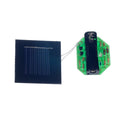







Buy locally from a partner
Bundled options
Kitronik Solar Garden Light with Battery plus wire cutters
 +
+

Kitronik Solar Garden Light with Battery plus wire cutters and soldering starter kit
 +
+
 +
+

Description
Same Day Dispatch
- Orders placed online before 3:00pm Monday - Friday (excluding public holidays and our Christmas shutdown period) are always dispatched the same day provided the goods are in stock. If the goods are not in stock we will endeavour to contact you as soon as possible to discuss a dispatch date.
UK Deliveries
- If you live on the UK mainland and don't have any large materials or lithium batteries in your order it will cost £4.50 (£5.40 including VAT) if you spend less than £50 (£60 including VAT).
- If you spend between £50 and £200 (£60 - £240.00 including VAT, excluding large materials or lithium batteries) delivery is free to most locations, and £15 (£18.00 including VAT, excluding large materials or lithium batteries) to UK remote locations. For a list of postcodes that will be charged the remote location rate: remote area list.
- If you spend over £200 (£240.00 including VAT, excluding large materials or lithium batteries) delivery is free within the UK.
Rest of the world
- These orders are sent via FedEx, and the cost is dependant on the service you choose at checkout. Alternatively you can choose the free collection option and have your own courier collect it from us. International orders can only be shipped to the registered card address. Please note: International orders may be charged import duty dependant on local import laws and duty rates. These charges are usually billed to you directly from FedEx.
- Delivery times vary for international orders depending on the service selected and the destination. You can see the delivery time and cost at the shipping stage, or by using the shipping estimator from within the shipping basket.
Collection
- If you would like to collect your order, or use your own courier then there is an option you can select during checkout. We do not charge a packaging or handling fee for this service, and you will receive an email when your order has been processed, you can collect half an hour after receipt of this email.
Further Information
- For information about all of the delivery options we offer see full delivery details.
These Solar Garden Lights were produced by students at Hawkley Hall High School.
These Solar Garden Lights were produced by students at Hawkley Hall High School.
This sun jar was made students at the Hardenhuish School using the Solar Light Kit. The design uses a recycled glass jar with some laser cut ply & Perspex.
This sun jar was made students at the Hardenhuish School using the Solar Light Kit. The design uses a recycled glass jar with some laser cut ply &...
How to solder - an introductory guide: If you're new to soldering our Soldering School will have you up and running in no time. What is soldering? Soldering is a...
How to solder - an introductory guide: If you're new to soldering our Soldering School will have you up and running in no time. What...
Emma shows you how to make a solar powered jam jar lamp. At the time of writing, the sun is just beginning to wind up for summer, so it's the...
Emma shows you how to make a solar powered jam jar lamp. At the time of writing, the sun is just beginning to wind up...
ltage of 3V so wouldn't work directly off the battery, instead the kit works by driving the LED only for 50% of the time but at twice the voltage. This is done so fast that you can?t see that the LED isn't constantly on, but it would mean that if you connected a colour changing LED to the board it would keep resetting and never move off red.
Ask a question about this product
Payment & Security
Your payment information is processed securely. We do not store credit card details nor have access to your credit card information.

 This product is designed and manufactured in the UK by Kitronik.
This product is designed and manufactured in the UK by Kitronik.


